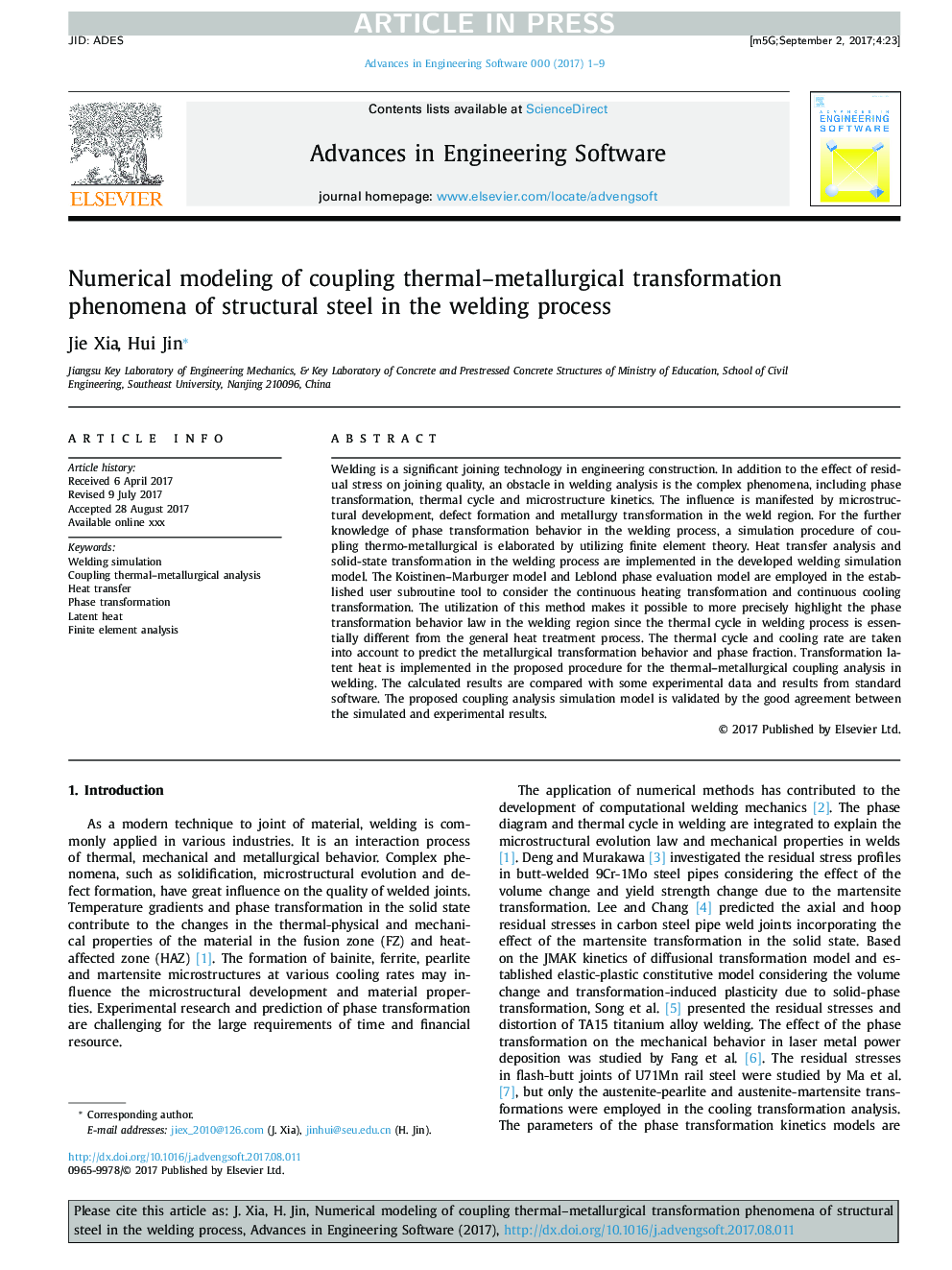| کد مقاله | کد نشریه | سال انتشار | مقاله انگلیسی | نسخه تمام متن |
|---|---|---|---|---|
| 6961425 | 1452102 | 2018 | 9 صفحه PDF | دانلود رایگان |
عنوان انگلیسی مقاله ISI
Numerical modeling of coupling thermal-metallurgical transformation phenomena of structural steel in the welding process
ترجمه فارسی عنوان
مدلسازی عددی پدیده تحول گرما-متالورژی جوش فولاد ساختاری در فرآیند جوشکاری
دانلود مقاله + سفارش ترجمه
دانلود مقاله ISI انگلیسی
رایگان برای ایرانیان
کلمات کلیدی
شبیه سازی جوش، جوش حرارتی تجزیه و تحلیل متالورژی، انتقال گرما، تبدیل فاز، حرارت نهان، تجزیه و تحلیل عنصر محدود،
ترجمه چکیده
جوش یک تکنولوژی قابل توجهی در مهندسی است. علاوه بر تأثیر تنش باقی مانده در کیفیت اتصال، مانع در تجزیه و تحلیل جوش پدیده های پیچیده، از جمله انتقال فاز، چرخه حرارتی و سینتیک ریز ساختار است. نفوذ آن به واسطه رشد میکرو سازنده، شکل گیری نقص و تبدیل متالورژی در منطقه جوش ظاهر می شود. برای کسب اطلاعات بیشتر در مورد رفتار انتقال فاز در فرآیند جوشکاری، یک روش شبیه سازی ترمو متالورژی جوش با استفاده از نظریه عناصر محدود می شود. تحلیل انتقال حرارت و تبدیل حالت جامد در فرآیند جوشکاری در مدل شیوه جوشکاری توسعه داده شده است. مدل کویستینن-ماربورگر و مدل ارزیابی فاز لالبوند در ابزار زیرمجموعه کاربر ایجاد شده برای در نظر گرفتن انتقال حرارت مداوم و تبدیل مداوم خنک کننده استفاده می شود. استفاده از این روش باعث می شود که دقیق تر قانون قانون رفتار تبدیل فاز در منطقه جوشکاری را برجسته کنید زیرا چرخه حرارتی در فرآیند جوشکاری اساسا متفاوت از فرایند عملیات حرارتی است. چرخه حرارتی و میزان خنک سازی برای پیش بینی رفتارهای تبدیل متالورژیکی و کسر فاز مورد توجه قرار گرفته است. گرمای نهان ترانسفورماتور در روش پیشنهاد شده برای تجزیه و تحلیل کوپلینگ حرارتی متالورژیکی در جوش اجرا می شود. نتایج محاسبه شده با برخی داده های تجربی و نتایج از نرم افزار استاندارد مقایسه شده است. مدل شبیه سازی تحلیلی پیشنهاد شده با توافق خوب بین نتایج شبیه سازی شده و تجربی معتبر است.
موضوعات مرتبط
مهندسی و علوم پایه
مهندسی کامپیوتر
نرم افزار
چکیده انگلیسی
Welding is a significant joining technology in engineering construction. In addition to the effect of residual stress on joining quality, an obstacle in welding analysis is the complex phenomena, including phase transformation, thermal cycle and microstructure kinetics. The influence is manifested by microstructural development, defect formation and metallurgy transformation in the weld region. For the further knowledge of phase transformation behavior in the welding process, a simulation procedure of coupling thermo-metallurgical is elaborated by utilizing finite element theory. Heat transfer analysis and solid-state transformation in the welding process are implemented in the developed welding simulation model. The Koistinen-Marburger model and Leblond phase evaluation model are employed in the established user subroutine tool to consider the continuous heating transformation and continuous cooling transformation. The utilization of this method makes it possible to more precisely highlight the phase transformation behavior law in the welding region since the thermal cycle in welding process is essentially different from the general heat treatment process. The thermal cycle and cooling rate are taken into account to predict the metallurgical transformation behavior and phase fraction. Transformation latent heat is implemented in the proposed procedure for the thermal-metallurgical coupling analysis in welding. The calculated results are compared with some experimental data and results from standard software. The proposed coupling analysis simulation model is validated by the good agreement between the simulated and experimental results.
ناشر
Database: Elsevier - ScienceDirect (ساینس دایرکت)
Journal: Advances in Engineering Software - Volume 115, January 2018, Pages 66-74
Journal: Advances in Engineering Software - Volume 115, January 2018, Pages 66-74
نویسندگان
Xia Jie, Jin Hui,
